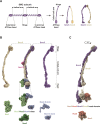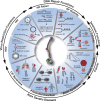The SMC5/6 complex: folding chromosomes back into shape when genomes take a break
- PMID: 38375830
- PMCID: PMC10954462
- DOI: 10.1093/nar/gkae103
The SMC5/6 complex: folding chromosomes back into shape when genomes take a break
Abstract
High-level folding of chromatin is a key determinant of the shape and functional state of chromosomes. During cell division, structural maintenance of chromosome (SMC) complexes such as condensin and cohesin ensure large-scale folding of chromatin into visible chromosomes. In contrast, the SMC5/6 complex plays more local and context-specific roles in the structural organization of interphase chromosomes with important implications for health and disease. Recent advances in single-molecule biophysics and cryo-electron microscopy revealed key insights into the architecture of the SMC5/6 complex and how interactions connecting the complex to chromatin components give rise to its unique repertoire of interphase functions. In this review, we provide an integrative view of the features that differentiates the SMC5/6 complex from other SMC enzymes and how these enable dramatic reorganization of DNA folding in space during DNA repair reactions and other genome transactions. Finally, we explore the mechanistic basis for the dynamic targeting of the SMC5/6 complex to damaged chromatin and its crucial role in human health.
© The Author(s) 2024. Published by Oxford University Press on behalf of Nucleic Acids Research.
Figures




Similar articles
-
Integrative analysis reveals unique structural and functional features of the Smc5/6 complex.Proc Natl Acad Sci U S A. 2021 May 11;118(19):e2026844118. doi: 10.1073/pnas.2026844118. Proc Natl Acad Sci U S A. 2021. PMID: 33941673 Free PMC article.
-
Loop-extruding Smc5/6 organizes transcription-induced positive DNA supercoils.Mol Cell. 2024 Mar 7;84(5):867-882.e5. doi: 10.1016/j.molcel.2024.01.005. Epub 2024 Jan 30. Mol Cell. 2024. PMID: 38295804
-
Functional interplay between cohesin and Smc5/6 complexes.Chromosoma. 2014 Oct;123(5):437-45. doi: 10.1007/s00412-014-0474-9. Epub 2014 Jul 1. Chromosoma. 2014. PMID: 24981336 Free PMC article. Review.
-
The SAGA histone acetyltransferase module targets SMC5/6 to specific genes.Epigenetics Chromatin. 2023 Feb 16;16(1):6. doi: 10.1186/s13072-023-00480-z. Epigenetics Chromatin. 2023. PMID: 36793083 Free PMC article.
-
Smc5/6, an atypical SMC complex with two RING-type subunits.Biochem Soc Trans. 2020 Oct 30;48(5):2159-2171. doi: 10.1042/BST20200389. Biochem Soc Trans. 2020. PMID: 32964921 Review.
Cited by
-
Separation-of-Function Alleles of smc-5 Reveal Domain-Specific Defects and a Conserved Residue Critical for Genome Maintenance.Biomolecules. 2025 May 23;15(6):755. doi: 10.3390/biom15060755. Biomolecules. 2025. PMID: 40563397 Free PMC article.
-
Intracellular Host Restriction of Hepatitis B Virus Replication.Viruses. 2024 May 11;16(5):764. doi: 10.3390/v16050764. Viruses. 2024. PMID: 38793645 Free PMC article. Review.
-
Human Smc5/6 recognises transcription-generated positive DNA supercoils.Nat Commun. 2024 Sep 6;15(1):7805. doi: 10.1038/s41467-024-50646-w. Nat Commun. 2024. PMID: 39242537 Free PMC article.
-
Protection of double-Holliday junctions ensures crossing over during meiosis.bioRxiv [Preprint]. 2025 May 11:2024.09.14.613089. doi: 10.1101/2024.09.14.613089. bioRxiv. 2025. PMID: 39314413 Free PMC article. Preprint.
-
Cohesin complex oligomerization maintains end-tethering at DNA double-strand breaks.Nat Cell Biol. 2025 Jan;27(1):118-129. doi: 10.1038/s41556-024-01552-2. Epub 2024 Oct 31. Nat Cell Biol. 2025. PMID: 39482358 Free PMC article.
References
-
- Bell O., Tiwari V.K., Thomä N.H., Schübeler D. Determinants and dynamics of genome accessibility. Nat. Rev. Genet. 2011; 12:554–564. - PubMed
-
- Kim E., Barth R., Dekker C. Looping the genome with SMC complexes. Annu. Rev. Biochem. 2023; 92:15–41. - PubMed
-
- Shintomi K., Inoue F., Watanabe H., Ohsumi K., Ohsugi M., Hirano T. Mitotic chromosome assembly despite nucleosome depletion in Xenopus egg extracts. Science. 2017; 356:1284–1287. - PubMed
Publication types
MeSH terms
Substances
Grants and funding
LinkOut - more resources
Full Text Sources
Molecular Biology Databases

